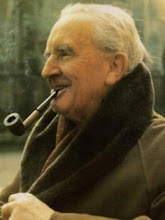 After the Ainulindalë, the next cycle in The Silmarillion deals with the Ainur - their characteristics, their powers, their relation with the world and its elements, and with eachother etc. There isn't really much to say about the Valaquenta, as it is quite straightforward, but I'll do my best for the benefit of those readers who perhaps haven't read The Silmarillion.
After the Ainulindalë, the next cycle in The Silmarillion deals with the Ainur - their characteristics, their powers, their relation with the world and its elements, and with eachother etc. There isn't really much to say about the Valaquenta, as it is quite straightforward, but I'll do my best for the benefit of those readers who perhaps haven't read The Silmarillion.When, with the grace of God, the Ainur entered the world at the dawn of Time, they were ''divided'' into two groups, depending upon their ''stature,'' called the Valar and the Maiar. The differences between these two can be said to resemble the differences between, say, a Seraph and an ordinary Angel in the real celestial hierarchy. Together, the Valar form a pantheon, with the Maiar as their servants and helpers. Each Maia was attached to one Vala (sometimes more than one), becoming one of their people. For example, Melian the Maia was of the people of Vána and Estë, and was akin before the World was made to Yavanna herself. More famously though, Olórin (who later became Gandalf the Grey) was of the people of Manwë and Varda.
I won't go through each individual Ainu one by one as I expect this may be tedious. As Tolkien explains, the primary function of the Ainur is to prepare the way for the Children of God (Elves and Men) and to exercise delegated authority within their spheres (NOT creation, making or reform). The Ainur had no part in the Great Music with the creation of the Children of Ilúvatar; as is told in the Ainulindalë: ''For the Children of Ilúvatar were conceived by him alone...and none of the Ainur had part in their making.''
Now, it was the task of the Ainur to fashion the world according to the design of Ilúvatar, to prepare the world for the coming of the Children, and the chief among these were Manwë, Ulmo and Aulë who were there from the beginning, but Melkor (Tolkien's Lucifer) was there before them and he contended with all that was done and drove the Valar into retreat. This would have been a time of primeval chaos and cataclysm - as yet there are no habitable lands, just roaring seas, darkness, tempests etc, but the Valar called upon aid from beyond the world and there gathered about them a great many companions, and they do battle with Melkor and his hosts for the mastery of Creation. But it was not easy. Tolkien describes Melkor thus: ''And he descended upon Arda in power and majesty greater than any other of the Valar, as a mountain that wades in the sea and has its head above the clouds and is clad in ice and crowned with smoke and fire; and the light of the eyes of Melkor was like a flame that withers with heat and pierces with a deadly cold.'' But for all that, by the grace of God, Melkor was defeated, for Tulkas the Strong came then to the aid of the Ainur and Melkor fled before him. The world then had peace, and the Ainur brought order and established their kingdom, but Melkor brooded in the outer darkness.
The above painting is Ted Nasmith's rendering of Illuin, one of the primeval ''Lamps of the Valar'' which gave light to the world long before the Sun and Moon.

No comments:
Post a Comment